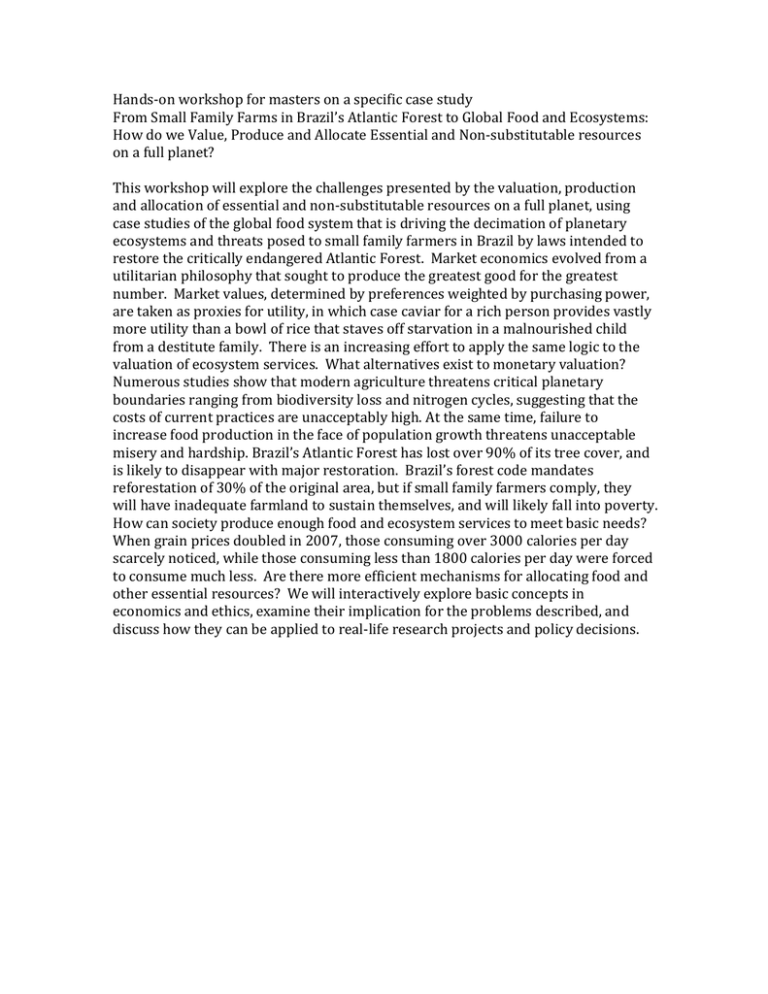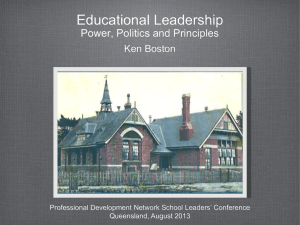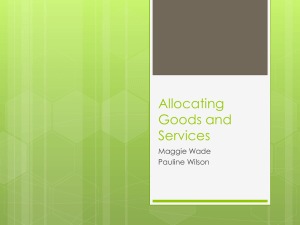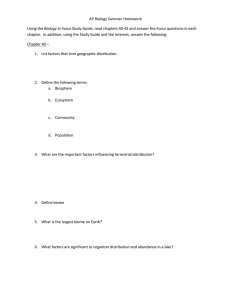Essential and non-substitutable resources
advertisement

Hands-on workshop for masters on a specific case study From Small Family Farms in Brazil’s Atlantic Forest to Global Food and Ecosystems: How do we Value, Produce and Allocate Essential and Non-substitutable resources on a full planet? This workshop will explore the challenges presented by the valuation, production and allocation of essential and non-substitutable resources on a full planet, using case studies of the global food system that is driving the decimation of planetary ecosystems and threats posed to small family farmers in Brazil by laws intended to restore the critically endangered Atlantic Forest. Market economics evolved from a utilitarian philosophy that sought to produce the greatest good for the greatest number. Market values, determined by preferences weighted by purchasing power, are taken as proxies for utility, in which case caviar for a rich person provides vastly more utility than a bowl of rice that staves off starvation in a malnourished child from a destitute family. There is an increasing effort to apply the same logic to the valuation of ecosystem services. What alternatives exist to monetary valuation? Numerous studies show that modern agriculture threatens critical planetary boundaries ranging from biodiversity loss and nitrogen cycles, suggesting that the costs of current practices are unacceptably high. At the same time, failure to increase food production in the face of population growth threatens unacceptable misery and hardship. Brazil’s Atlantic Forest has lost over 90% of its tree cover, and is likely to disappear with major restoration. Brazil’s forest code mandates reforestation of 30% of the original area, but if small family farmers comply, they will have inadequate farmland to sustain themselves, and will likely fall into poverty. How can society produce enough food and ecosystem services to meet basic needs? When grain prices doubled in 2007, those consuming over 3000 calories per day scarcely noticed, while those consuming less than 1800 calories per day were forced to consume much less. Are there more efficient mechanisms for allocating food and other essential resources? We will interactively explore basic concepts in economics and ethics, examine their implication for the problems described, and discuss how they can be applied to real-life research projects and policy decisions. Focus on essential and non-substitutable resources What are they? Meet physiological needs, basic survival Thresholds inherent to the analysis What about flow thresholds and stock thresholds? How do we deal with time lags? Do ecosystem services qualify? Quote from Schelling Substitution and income What is the relationship with utility? Specific focus on food and ecosystem services Definition of economics What are desirable ends? Value is contribution to desirable ends? Marginal values vs. total values. What are scarce resources and their characteristics? Focus on food and ecosystem services How do we allocate? Allocating resources towards desired products Allocating products among individuals Essential and non-substitutable resources Towards what desired ends should we allocate these resources? Maximizing GDP How do we do this with essential and non-substitutable resources? Maximizing human welfare What are their market characteristics? Food Rival Excludable Stock-flow How do we value? Marginal value vs. total value, relationship to GDP. Inelastic demand What happened to wheat prices in 2007? What was impact on your consumption of bread? How essential is the marginal loaf of bread to you vs. a destitute person? Who reduced their consumption the most? Why? What else contributes to elasticity of demand? Physiological threshold (short time lag) Ecosystem services Non-rival Non-excludable Fund-service How do we value? WTA vs WTP (voting) How should we value? Weighting by purchasing power or physiological need? Essentiality, scarcity, direction of change Inelastic demand Ecological threshold (long time lag) How will markets choose to allocate between ES and food? What is the relationship between thresholds and marginal values? Allocation To whom do markets allocate these resources? How do we allocate resources for which there is no market? Who should have a say in the allocation of these resources? Who should be entitled to use them? How should we allocate non-rival resource? Irreconcilable conflicts? Planetary boundaries Time lags Malnutrition (FAO/UN) Reliance of ag on non-renewable resources Substitution of fund-service for non-renewable stock flow Atlantic Forest and ecosystem services Small family farmers and livelihoods What are market driven outcomes? Need new technologies along with economic institutions that invest in those technologies, make their adoption preferable to conventional ag, Possible solutions Agroecology What type of investments are required? R&D Extension Building markets Monetary valuation How are values calculated? One dollar, one vote Substitutes for drinking water, vulnerability to landslides, etc.? PES Who should fund it? Public good nature of benefits Spatial distribution Who should receive the payments Farmers? Does this work for developing the technologies? Does it provide incentives for farmers to adopt them? What would lead farmers to adopt agroecology? Low risk credit Extension, pilot projects Should we invest? Rethinking CBA How do we value market goods and services? How do we value non-market goods and services? How should we allocate? What is efficiency? Rationing function of price. Other ideas What is justice? Should sustainability and justice take precedence over ‘efficiency’ ? Discussion over sustainable scale Will we develop substitutes? Do thresholds exist? What are ethical obligations to future generations in the presence of profound uncertainty? Price rationing vs. quantitative rationing: California vs. Brazil





